You may have heard of mead before or maybe you haven’t, but one image that always seems to come to mind when mead is mentioned is Vikings drinking their grog. I don’t know a whole lot about Vikings, but I do know a bit about mead! Mead is a fermented honey and water mixture, some call it honey wine, and it is quite possibly the first fermented drink that humans purposefully made. Luckily for us, it’s quite easy to make your own mead! I’m going to show you how to make one gallon of mead with this simple blueberry orange mead recipe.
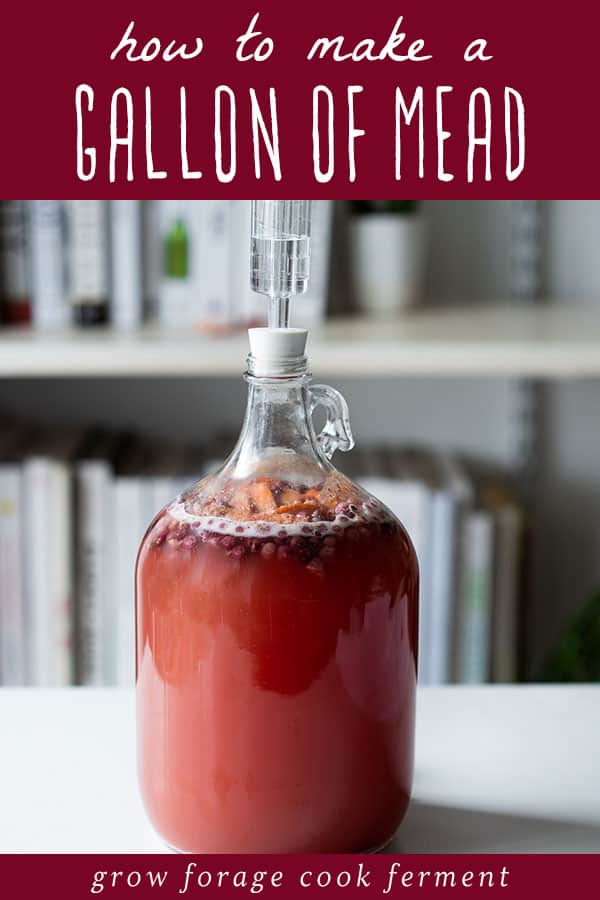
Want to save this post for later?
Simple Mead Making eBook
Want to learn more about making mead? I have a Simple Mead Making for Beginners eBook just for you!
It has ingredient and equipment checklists, detailed instructions for brewing and bottling your mead, and simple mead recipe ideas! Be sure to check it out if you’re new to the mead making process and want a step by step guide.
One Gallon Mead Recipe
Here is my simple method for making one gallon of mead!
What is Mead?
Mead is a fermented alcoholic beverage that is traditionally made with just honey and water, and maybe some yeast (wild yeast is often used).
Whenever you add fruit to mead it’s technically called a melomel rather than mead. I still usually default to calling it mead, though.
You could also use apple cider instead of water and then you’d have what’s called a cyser. If you add herbs and spices or other flavorings it’s called a metheglin.
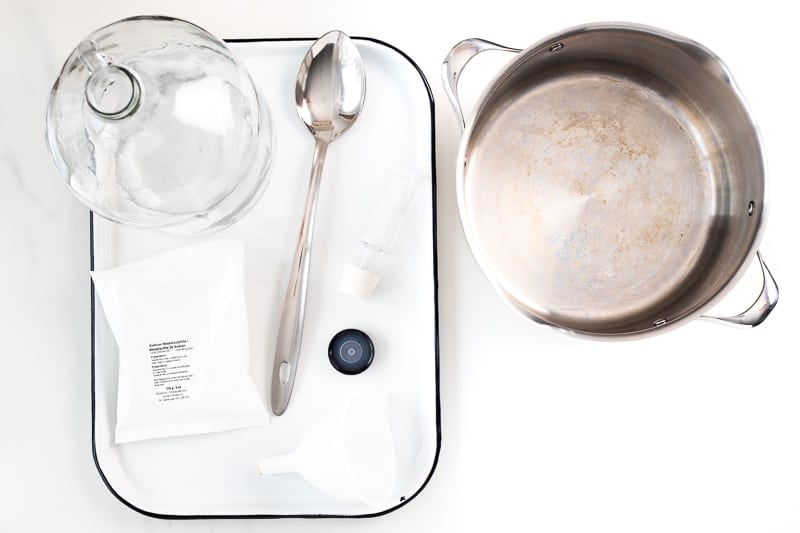
Mead Equipment and Ingredients
There is some special equipment and ingredients that you will need to make this mead.
Rather than list it all here, I’ve created a page that has links to all of my favorite mead ingredients and equipment: Mead Equipment & Ingredients: Everything You Need to Get Started.
There you will find links to the sanitizer, brewing jugs and buckets, airlocks, yeast, tubing, bottles, and honey and I recommend!
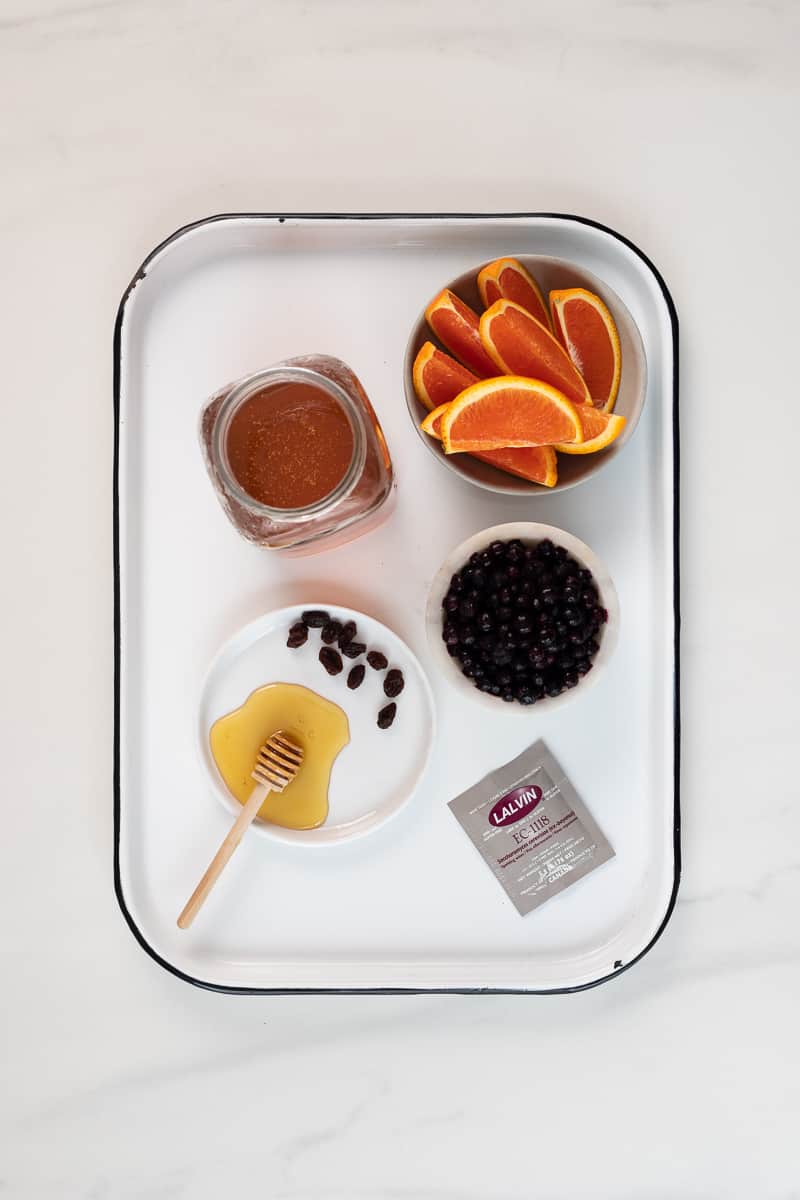
How to Make Mead: One Gallon Mead Recipe
Alright, let’s get started on making this mead!
This is a recipe for one gallon of mead, but I’m always of the mind that if you’re making one you might as well make two.
You can split a package of brewing yeast up between two jugs (one package can make up to 5 gallons of mead).
Sanitize Everything
The first thing to do is sanitize everything that will be used in the brewing process: the jug, airlock, big pot, spoon and funnel.
Simply follow the directions on the sanitizer and don’t throw it out until you’re totally done (just in case your dog licks the funnel or you drop your spoon).
Make the Mead Must
Once everything is sanitized, put about 1/2 gallon of non-chlorinated (filtered) water in a large pot on medium heat. When it’s warm, but not boiling, add the honey and stir until it dissolves.
Using two pounds of honey will make a very “dry” mead (not sweet), while three pounds will create a sweeter mead.
The type of yeast you use will also affect how dry or sweet the mead is.
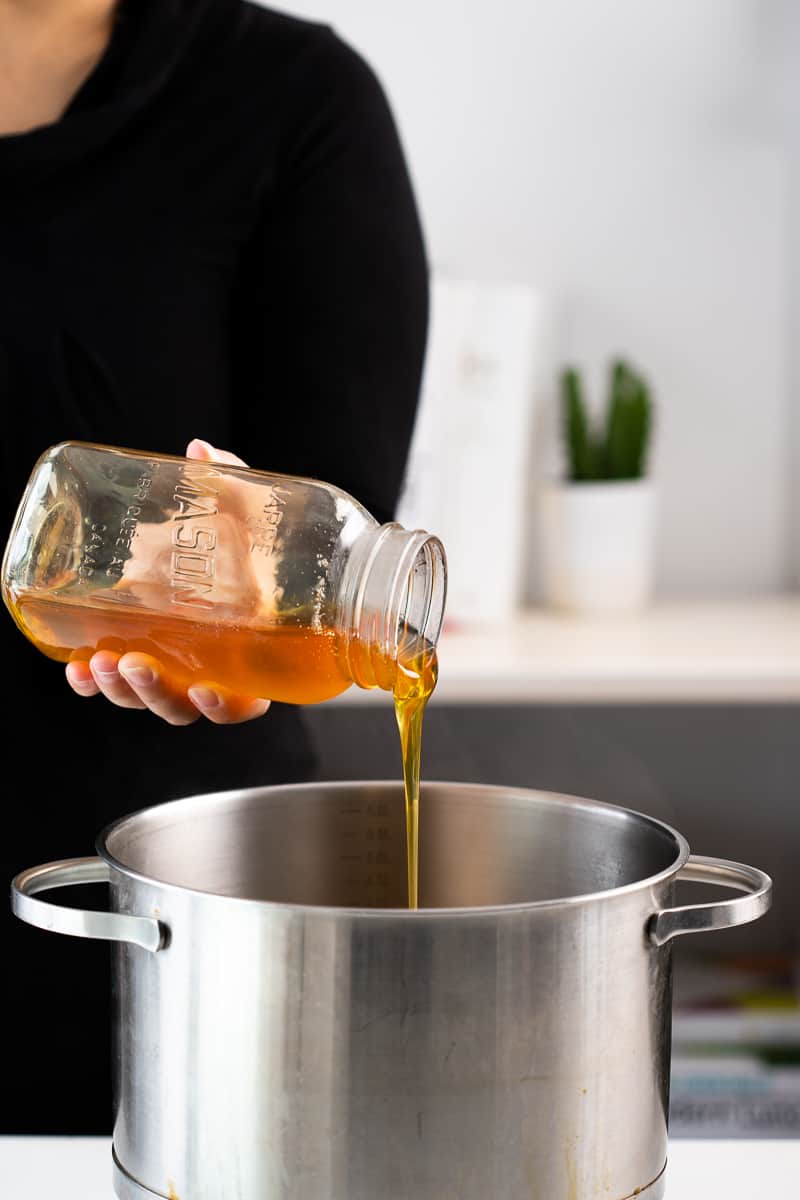
Turn the heat off. It may be a little foamy, but that’s ok.
In the meantime, put the berries (or any fruit of your liking), orange slices (skin and all), and raisins into the one gallon jug.
Raisins are added as a natural nutrient for the yeast. You will not notice any flavor from them in the finished mead.
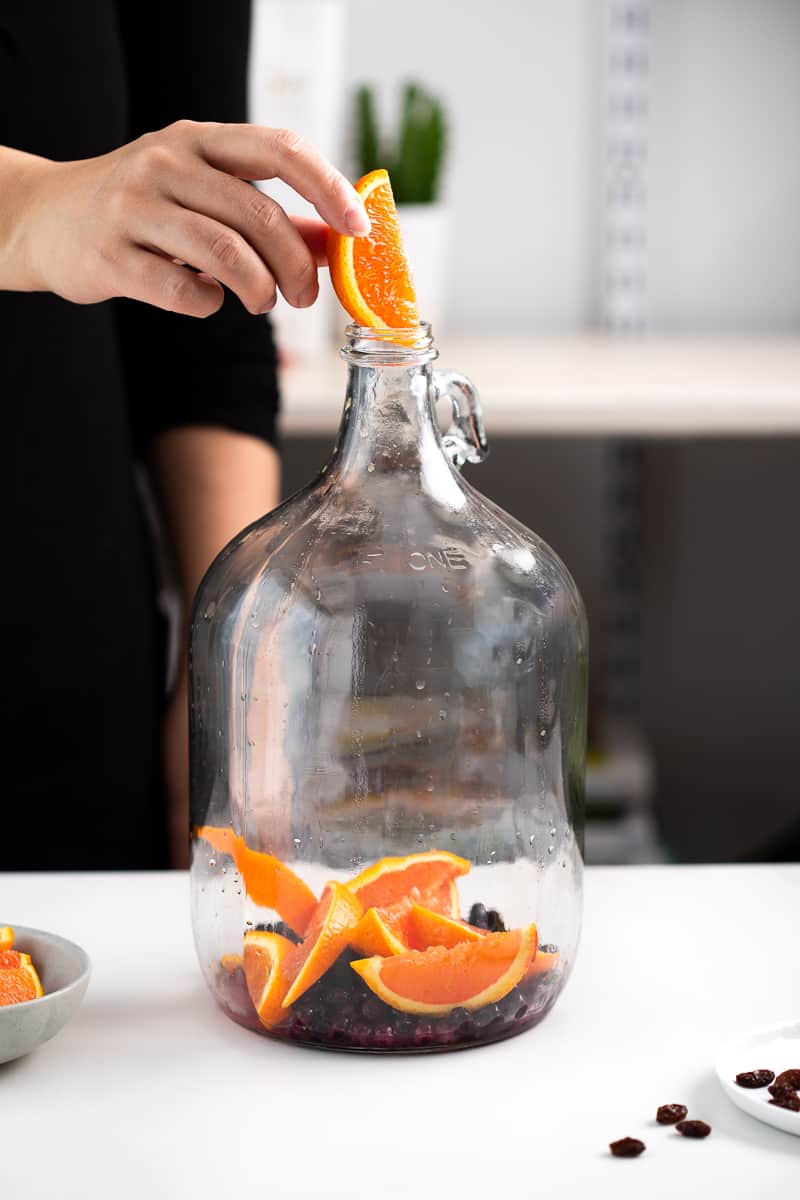
Then, using the funnel, carefully pour the honey water mixture (technically called “must”) into the jug.
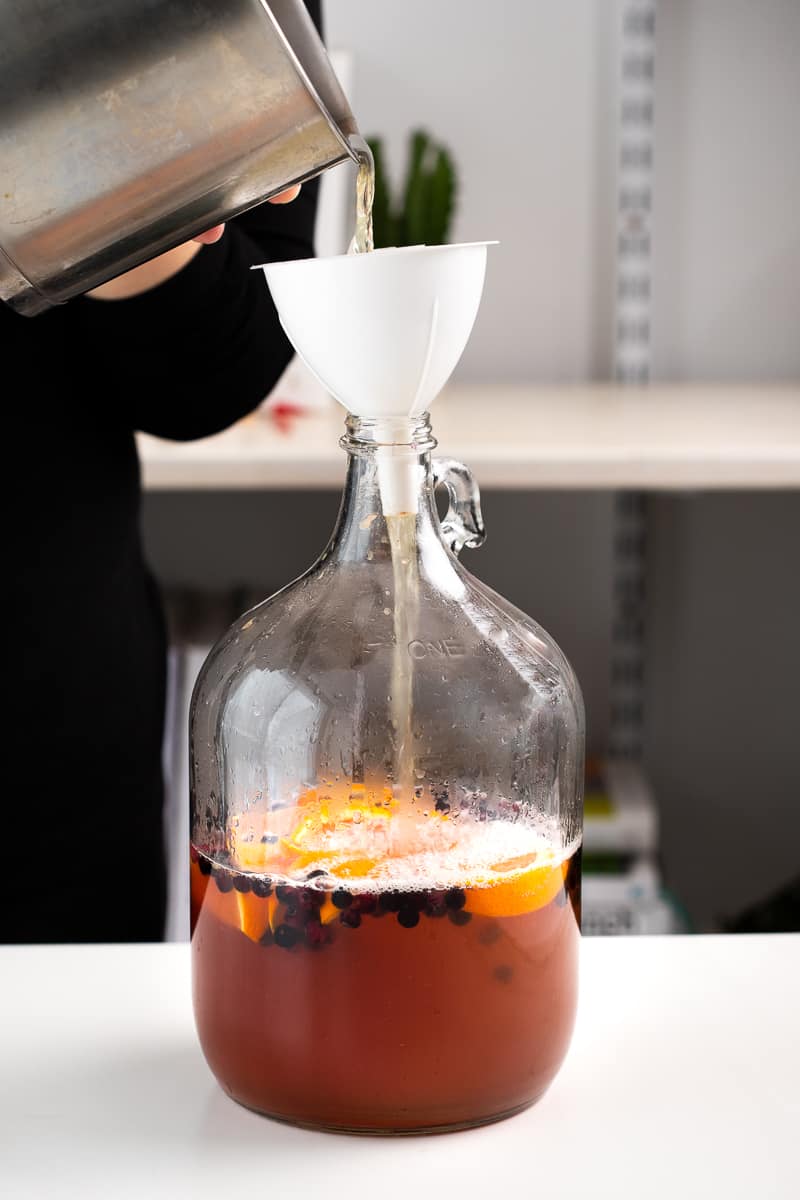
Top off the jug with cool non-chlorinated (filtered) water, leaving at least 2 inches of head space on top.
Then put the lid on the jug and gently mix everything around a bit. If you bought a jug that came with an airlock it may not come with a lid, so you’ll have to find a lid that fits or improvise a bit here. A solid cork (without a hole for the airlock) would work.
Pitch the Yeast
The next step is to add the yeast, but you need to make sure that it isn’t too hot, which will make your yeast inactive. It should feel lukewarm, no more than 90° F (32° C). I recommend using a thermometer before adding the yeast to be sure.
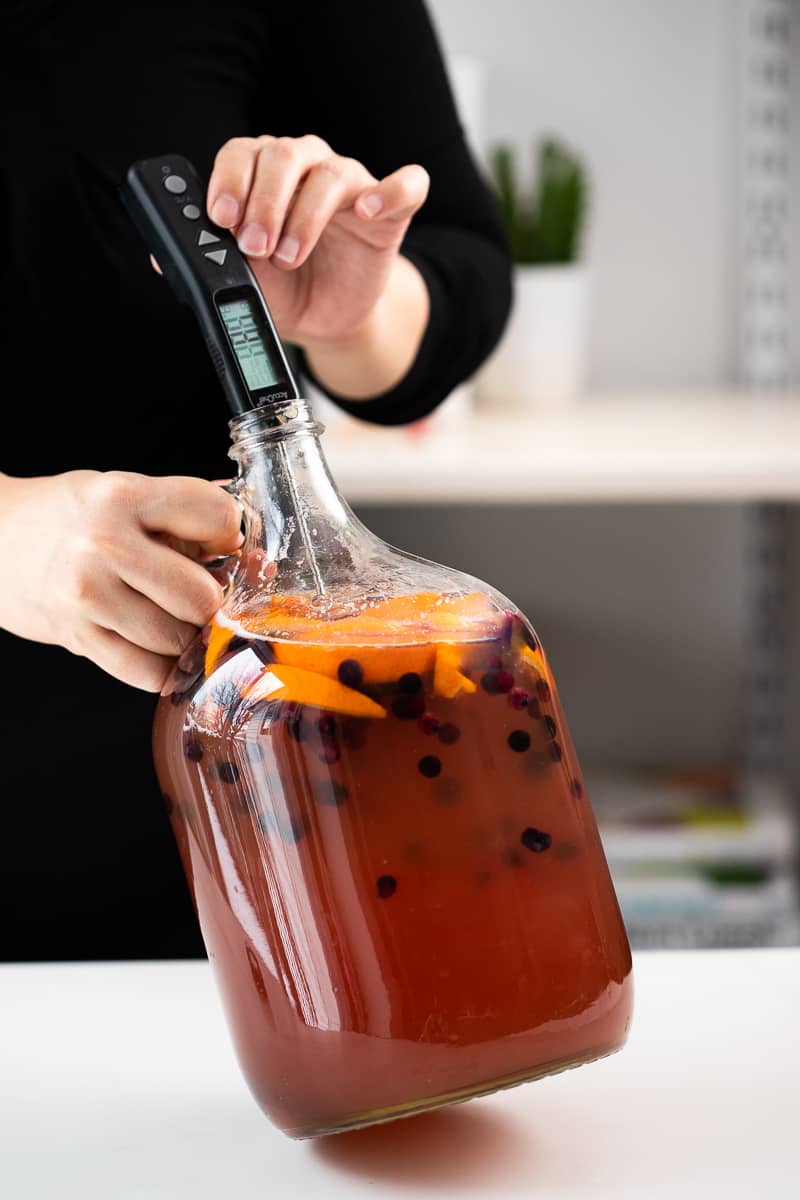
Once it is less then 90° F you can pitch the yeast into the jug.
You don’t need to use the whole package of yeast for one gallon, 1/2 package is enough (it doesn’t have to be an exact measurement). Store the opened yeast package with the remaining yeast in an airtight zip top bag in the refrigerator for later use.

Now the fermentation fun can begin!

Once you’ve pitched the yeast, put the lid back on tightly and this time you’re really going to shake it up for several minutes.
It’s a good workout for your arm muscles, so you can skip the gym on days when you make mead!
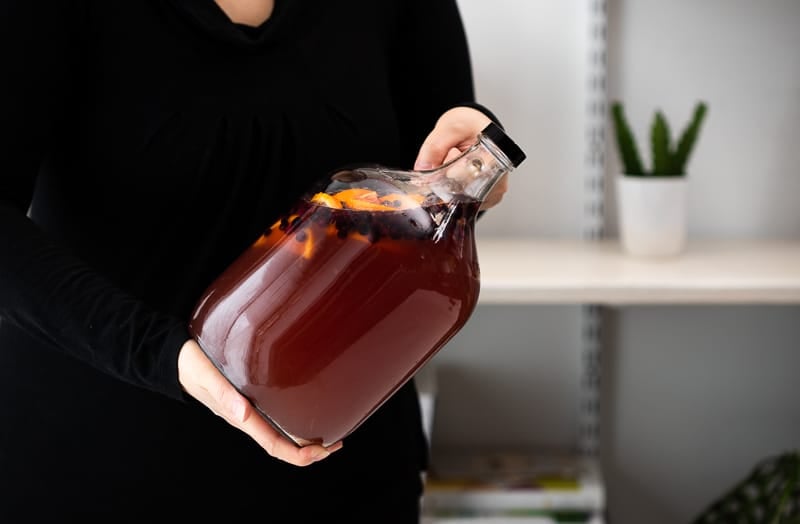
Add the Airlock
Put a little water in the airlock to the line, then put the rubber stopper into the jug.
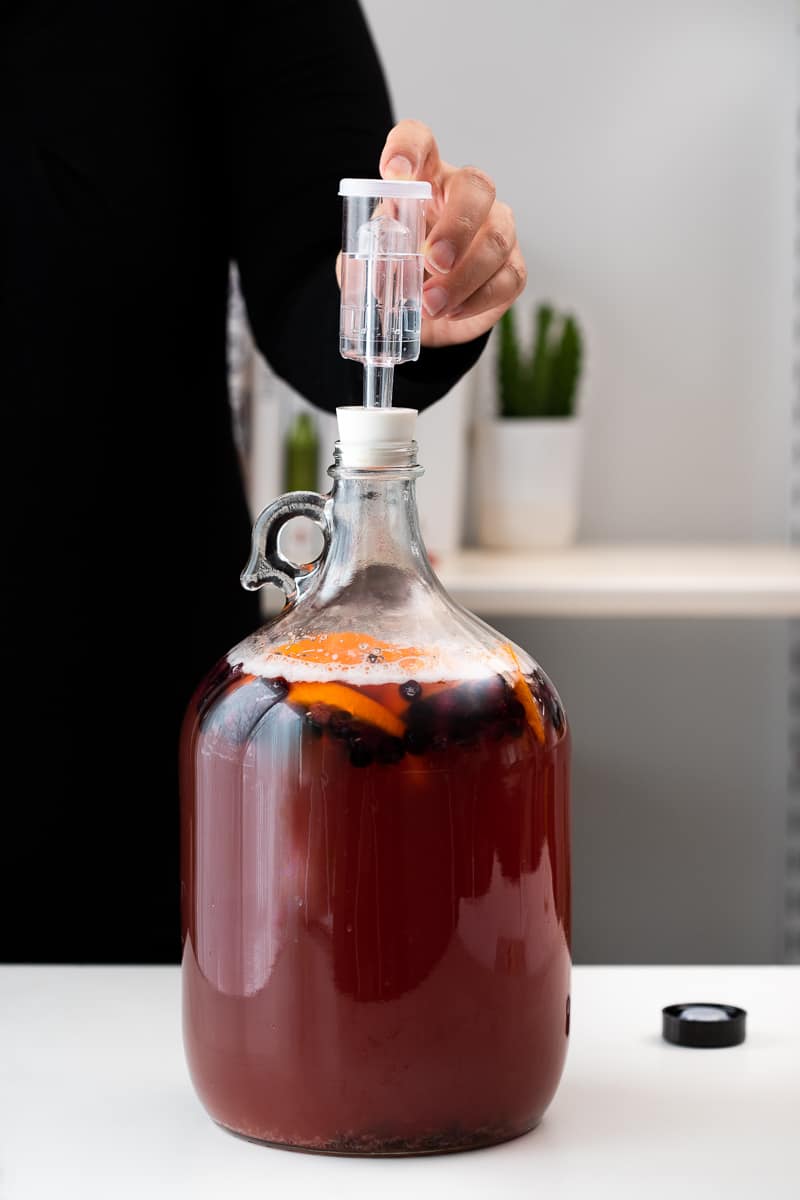
In a few hours you should start to see bubbles forming in the jug and in the airlock.
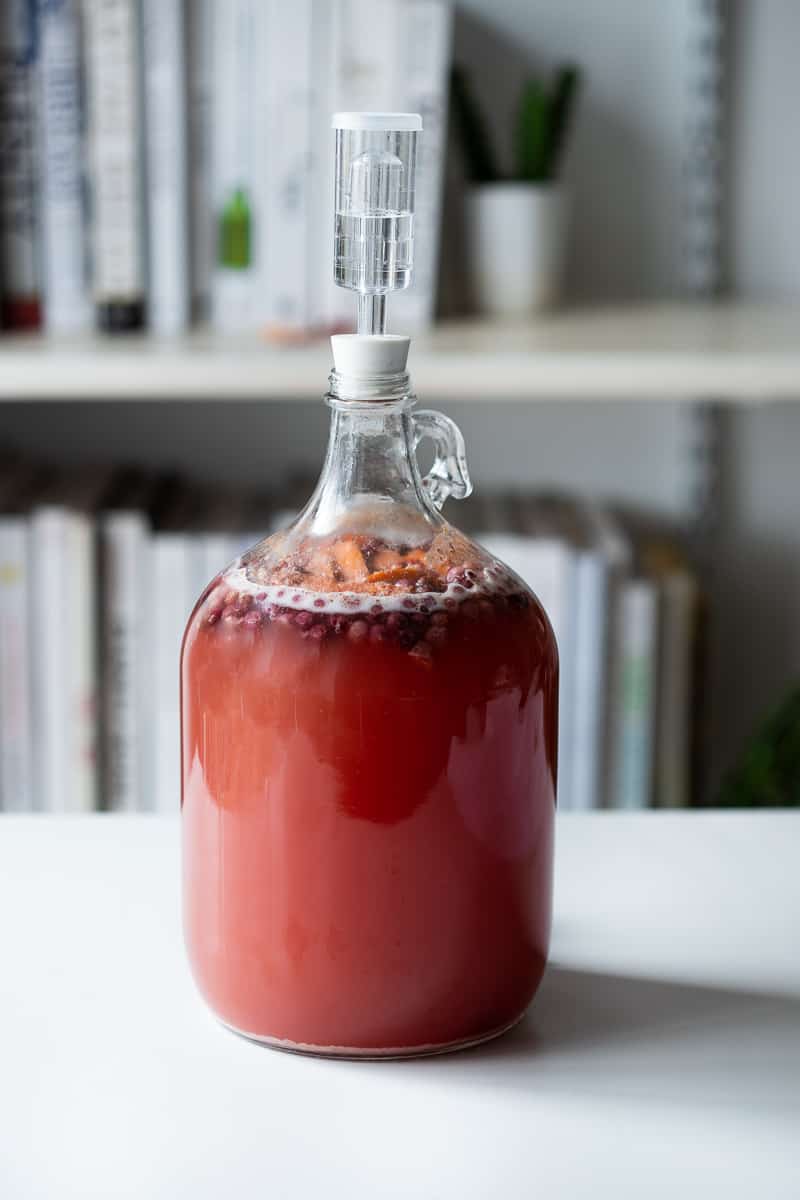
After several hours or overnight, you may see a lot of bubbles rising up the neck of the bottle! The whole top might get a little foamy at first, but things will settle down.
Don’t worry if the bubbles rise up into the airlock for the first couple of days, that just means that you have a very active (and happy) batch of mead! You can periodically remove the airlock to rinse it out, then replace it back into the jug.
I love watching all the little bubbles! Fermentation is so cool.

Set Aside to Ferment
Keep the jug in a cool (not cold) dark place out of direct sunlight to ferment.
Mead can take longer to ferment than hard cider or beer, depending on the ambient temperature it will take anywhere from 3-6 weeks.
I usually give it 5-6 weeks before bottling to be on the safe side, as you don’t want any broken bottle explosions! I’ve definitely had some very champagne like mead before.
You want to wait until you don’t see any bubbles in the jug and your airlock is still before bottling.
Bottle the Mead
Bottling one or two gallons of mead is the same process as bottling hard cider. Follow my tutorial there to get a detailed process.
You may want to wait a while to drink your mead as it definitely gets better with age.
I often drink it “green” (young) as I enjoy it either way. It is fun to save a couple of bottles for several months, or even a year, just to see how the taste changes with age.
More Mead Recipes
Now that I’ve shown you how to make this simple one gallon of mead recipe, chances are you will want to make more soon!
I have written posts on How to Make 5 Gallons of Mead and How to Bottle 5 Gallons of Mead if you want to try making a larger batch.
I have one gallon mead recipes for Wildflower Mead, Dandelion Mead, Blackberry Mead, Elderberry Mead, Elderflower Sparkling Mead, and Maple Orange Mead that are all delicious and follow this same basic mead recipe.
See my post on 15 Easy Mead Recipes for Beginners for even more!
If hard cider is your thing, see my posts on brewing hard cider and making hard cider with wild yeast.
Be sure to check out my Simple Mead Making: A Beginner’s Guide to One Gallon Batches eBook for more detailed information on brewing, bottling, and recipe ideas!
Cheers and happy mead making!
Simple One Gallon Mead Recipe
Equipment
Ingredients
- water non-chlorinated or filtered
- 2-3 pounds honey depending on how sweet you want to end product to be.
- berries or fruit of any kind fresh or frozen, about a cup
- 1 orange
- 10 raisins
- 1/2 package champagne yeast or other wine yeast
Instructions
- Sanitize everything that will be used in the brewing process.
- Heat about 1/2 gallon of non chlorinated water in the pot on medium heat. Once it's warm, but not boiling, add the honey and stir it so it all dissolves. Turn off the heat.
- Put the berries or other fruit, orange slices (skin and all), and raisins into the one gallon jug.
- Use the funnel and carefully pour the honey water mixture into the jug.
- Top off the jug with cold (preferably filtered) water, leaving at least 2 inches of head space on top. Put the lid on the jug and gently mix everything around a bit.
- Make sure that the temperature of the must is below 90°F, then add 1/2 packet of champagne yeast. Put the lid back on tightly and this time shake the jug for a minute or two to distribute the yeast.
- Put a little water in the airlock to the line, then put the rubber stopper end into the jug. Put the jug in a dark place. It should start bubbling within 12-24 hours.
- After about 4-6 weeks of fermenting, once all bubbles have stopped rising in the jug and airlock, the mead can be bottled and aged.
Notes
- Please see my Mead Equipment and Ingredients page for a detailed list of what you need to get started.
- Use my tutorial on Bottling Hard Cider to bottle the mead - the process is the same. The flavor of homemade mead will improve after bottling and aging.
- My Simple Mead Making eBook is a helpful resource if you are just getting started with making your own mead.
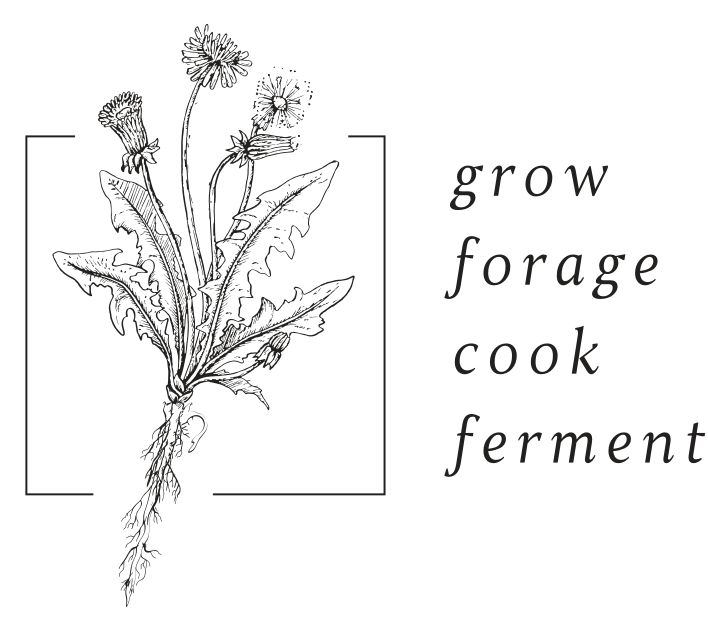
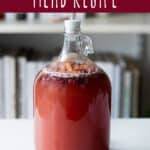


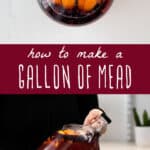
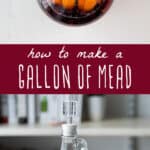
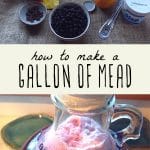
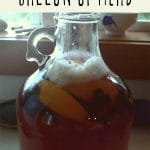
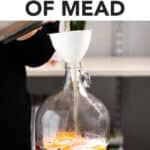
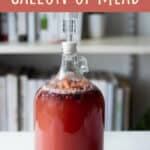
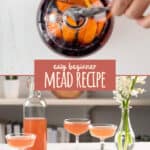




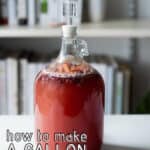
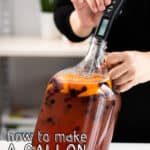
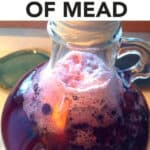
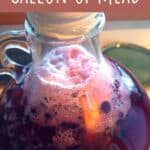
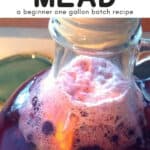


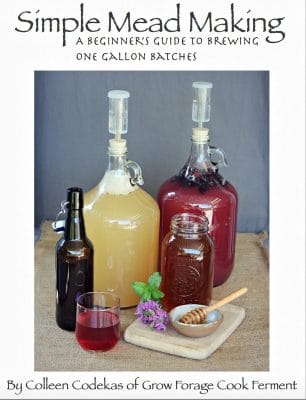


Hey there. I am brewing mead for the first time today. I have the recipe n all. I followed the steps too. Now after 4hrs of mixing all my ingredients, I’m looking at cloudy sponge like thingies all over the bottom n top of my mead. Is that normal? Kindly help. I would post a picture but I couldn’t attach here.
Hi Marina, yes that sounds like the yeast is doing its thing!
So, like another person’s my mead has stopped bubbling after 2 weeks and everything has settled to the bottom and is starting to clear up. I am wondering if it is okay to bottle. I have the mead stored in a cupboard and the house is between 68-70 degrees. I am afraid that it will start to go bad with the cinnamon stick lying on the bottom. Should I rack it, leave it be or bottle it
It sounds like it’s time to rack your mead.
Hello, we made your recipe last year and it was great. Trying again this year for 3 gallons, and one of them we used the rest of the open yeast packet, it was stored in a baggie but not in the fridge. Now one of the gallons isn’t bubbling and the other two are very active. We are afraid it may be because of the old yeast packet. Is there any way to salvage the inactive gallon? TIA for any suggestions and thanks for sharing your recipes!
Hi Meleah, yes that is likely the problem. An open package of yeast will last for a few months at most, and it does need to be refrigerated.
Regarding the S.S. pot, what size do you recommend>?
Hi Gryph, a two gallon pot works great!
Hello! I found your mead recipe about a year ago and finally got the gumption to try it out. I didn’t add fruit but followed the rest of the instructions to a t. It’s been sitting for four weeks and it never really foamed very much but I gave it a stir every day (swishing the bottle around a bit) and tiny bubbles would rise to the surface and would escape through the airlock. I decided to remove the airlock today to see if it smelled like alcohol. It smells more like vinegar than alcohol. Do you think I did something wrong? I was reading forums that refer to green or hot mead as burning like jet fuel. Should I bottle it, age it, and see what happens?
Hi Wayne, it’s really hard for me to say without knowing the exact ingredients and process you used and seeing it for myself. Mead is usually pretty harsh before bottling and aging, so it may just need some time to mellow out. I think bottling it and giving it some aging time is a good place to start!
Hi,
I brew a batch of the mead and a batch of the hard cider about 2 weeks ago.. I added about a litre more water than I should have, to get to 5 litres, so the gravity was lower on both.
After the two weeks the fermentation has slowed significantly (barely any bubbles but not flat looking) and the airlock has no activity. Everything still looks and smells OK. I’m wondering should I bottle it? Maybe stick a campden tablet in first?
Thanks, great recipes too btw!
Hi, John! If everything looks and smells okay, I would say it’s time to start bottling it! Happy brewing!
Getting ready to start my first gallon, it’s going to be an orange huckleberry mead. Do you think it would be alright to supplement the flavor using high quality, natural flavor extracts?
I prefer to let the natural fruit and honey flavors shine through, but you totally can add extracts if you like.
This is the first that ive learned about Mead and I am so excited to get started. Is it necessary to make a whole gallon or can I cut the recipe in half? Where can I purchase an airlock? And approximately what serving size gets you intoxicated? So excited to join your newsletters. It is some of the knowledge that I’m fascinated to learn. Thank you. Salud!
Hi there, Laurie. You can definitely use a half-gallon mason jar for your mead. Make sure to buy an airlock that can be used on a wide mouth mason jar. These look great.
Mead can have more or less alcohol than wine, so it really depends on your own tolerance. You can use a hydrometer if you’d like to measure the alcohol percentage of your mead after it’s made.
Do you have to age the mead? Or after it’s done fermentation can I just drink it? Also I followed the recipe but is it okay if I’m not getting enough foam for the mead? I left out the berries and just left the orange slices. It’s bubbling but not as foamy as in the picture… Look forward for a reply, thanks.
Hi Luis, as long as you are getting bubbles then it’s ok, it doesn’t need to be as foamy as the picture. I generally recommend aging the mead for at least a month, as that will mellow out the flavor.
Can I use dried elderberry? If so how?
You can use dried elderberries. I have a recipe for elderberry mead that has more details.
Would it be detrimental to omit the orange slices?
Nope. It should work. The acid does help balance the flavor out a bit, but is not imperative to the making mead process.
I started my batch and just wondered what the percentages will be when finished. When it is bottled green and aged if at all different
Hi Michael! You’ll need to use a hydrometer to find the ABV of your mead.
Hi, it’s been longer than 6 weeks since I made a gallon of mead. Is it still safe to bottles it if I haven’t yet. Life got in my way! I will be heart broken if I messed up!
6 weeks isn’t too long. You can proceed with bottling it.
Hi, I’ve read with other ferments that you want to make sure the fruit is below the liquid level so it doesn’t mold so they use weights to push it down. Should that be utilized here?
It should be fine in this case. Each day, I’ll gently swirl my mead around to resubmerge any floaters.
Hi, I’m a first time mead maker. I’m trying both your honey mead (melomel – with pears) and the maple/acerglyn mead recipes. They are bubbling away nicely in a cool closet. Since I’m new to this, I’ve been reading a lot about mead making on various blogs and forums. Are your mead recipes “quick meads”. I keep reading about leaving the mead in the carboys until they are clear before bottling. Do I need to wait until my mead is clear? Or should I just go ahead and bottle it after six weeks?
Hi I made my first gallon of mead on September 25th sterilized everything went according to recipe. Put in 1/2 orange peel & handful of chopped raisins. It started perking within 24 hours & I swirled the jug a little everyday. But now today I’m seeing what looks like mold on one side of some of the raisins! Is all lost? ☹️
Nope. Unless it’s black mold you’re seeing, it’s likely kahm yeast or dead yeast. Here’s a post about kham yeast I wrote about it on Fermentools that explains more.
Hi
I started my first fruit mead yesterday using sloes.
There is plenty of foam on top but no bubbles through it.
Do you think its working ok ?
Yes, it sounds like you’re on your way to a healthy ferment!
Must I pasteurize the bottled mead prior to aging?
Hi Steve, no the mead does not need to be pasteurized before bottling.
Hello. Your recipts? Is that us gallon or uk gallon? You USE?
Hi, Monica! It’s a US gallon.
Hi! Just started a batch yesterday, two gallons, one orange and one blackberry! Question: I’m a first timer, is this going to be carbonated at the end of 6 weeks? Do I need to be concerned with any potential blowouts when I go to bottle this and cork it up? Pretty pumped about this, and was fun to make!
Hi Marc, it might be a little carbonated, but shouldn’t be too much. I like to wait to bottle until there is little to no bubbles left in the jug to avoid blowouts.
My first gallon stopped bubbling after 7 days basically. What went wrong? I started 2 more gallons on the 17th. Will see?!?
Hi Bob, hmm I’m not sure. Was it in a warm climate? What kind of yeast did you use? Are there any bubbles still coming up in the jug? All ferments are different so it’s hard to know what happened without more details.
How can one turn this into a sparkling mead ?
Thanks!
Hi Denise, it often turns out to be slightly sparkling. You could bottle when there are still a few bubbles coming up in the jug, but this can also cause bottle explosions so you need to be careful!
Can you use scupendines with the orange and raisens,Will it taste good
I’m not really sure, but you could experiment with them. I’ve never tried them before, sorry!
Is Mead Wine
Mead is honey wine.
For mead – can I use frozen strawberries and liquid in one gallon batch and how much of berries , am using 3 #s of honey
Hi Dave, yes you can use frozen strawberries, and you’d want to keep it at one cup of fruit per gallon.
Can I serve it out of the jug or must i bottle it?
You should bottle it. Mead, like wine, matures and improves in flavor as it ages.
It seems like my mead stopped fermentation after only two weeks? I’m not sure if that means something went wrong? Bubbles have stopped rising and the airlock is still… Do you think I should just bottle now or give it another week?
Hi Jade, this can be caused by warmer weather, I’m sure that everything is fine!
Just started the fermentation process. It’s been about 4 hours and it’s already foaming into the airlock! Very exciting!
Yay! I hope it turns out great!
When I first started making mead, the first few days, I used a balloon rather than a vintage lock because the fermentation would blow the water out of my trap. I didn’t want air to get in and screw up my batch. this was important to me because I started making mead before I was of legal drinking age, so every drop counted. I had my own beehives for the honey. 55 years ago now.
Wow, Charles. That’s impressive!
How hard was it to clean the fruit out of that jug? What about an equally sized fermentation jar with a wider mouth?
Also, how long do you age it for?
Hi Randy, the fruit is usually pretty disintegrated by the time fermentation is complete, so it comes out fairly easy. You could use a small fermentation bucket, but you do need to make sure to use something that you can use an airlock with to avoid exposure to air. The mead can be aged anywhere from a few weeks to a few years! I generally like to give it at least a month.
Suggestions on what to do if its started to foam through the airlock? I’m only 4 days in, I’m surprised to see it so active…
That’s okay! You can remove your airlock, clean, and resanitize before replacing it.
Super easy recipe just started yesterday making my first batch.
For my second batch I was just given unfiltered raw honey, has the comb still in it. Is this OK to use and does anyone have experience?
You can use unfiltered honey, but there is no real benefit in doing so. However, if you do decide to use it, you’ll need to strain out all the bits of wax, wood, and other debris.